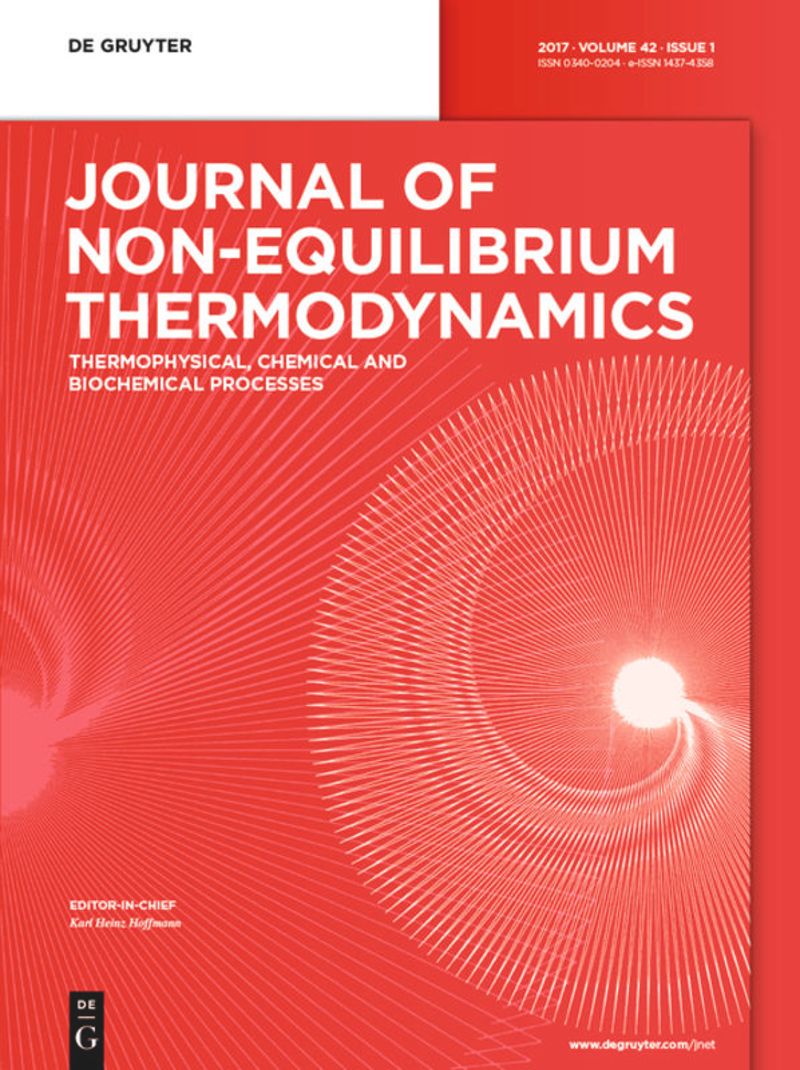Kinetic and thermodynamic approach to precisely solve the unsteady Rayleigh flow problem of a rarefied homogeneous charged gas under external force influence
IF 4.3
3区 工程技术
Q1 MECHANICS
引用次数: 0
Abstract
Abstract An extension and further development of our previous article [J. Non-equilibrium Thermodyne. 37 (2012), 119–141] is presented. We study the irreversible non-equilibrium thermodynamics (INT) properties of the exact solution to the dilute homogeneously charged gas problem with unsteady Rayleigh flow. In contrast to previous research, the charged gas flows under the influence of an external force, the flat plate oscillates, and the displacement current term is considered, leading to significant advancements in understanding natural plasma dynamics. We are solving the Boltzmann kinetic equation (BKE) Krook model supplemented by Maxwell’s equations. We used a travelling wave and moments method with an electron velocity distribution function (EVDF). To the best of our knowledge, as three new scientific achievements, we introduced a new mathematical model for calculating the thermodynamic forces, kinetic coefficients, and fluxes variables, Equations (28–40) and (50–54). Second, we determined, with reasonable accuracy, the thermodynamic equilibrium time of electrons, t equ = 26.7955, under an external force. We clarify the difference between equilibrium EVDF and perturbed EVDF and take advantage of BKE to account for non-equilibrium thermodynamic principles. For diamagnetic and paramagnetic plasmas, the extended Gibbs equation predicts ratios between various contributions to the internal energy change (IEC) is presented. A standard laboratory argon plasma model is used to apply the results.用动力学和热力学方法精确求解外力影响下稀薄均质带电气体的非稳态瑞利流问题
摘要 本文是我们之前文章[J. Non-equilibrium Thermodyne. 37 (2012), 119-141] 的延伸和进一步发展。我们研究了稀释均质带电气体问题非稳态瑞利流精确解的不可逆非平衡热力学(INT)特性。与以往研究不同的是,带电气体在外力作用下流动,平板振荡,并考虑了位移电流项,从而在理解自然等离子体动力学方面取得了重大进展。我们正在求解以麦克斯韦方程为补充的玻尔兹曼动力学方程(BKE)克罗克模型。我们使用了带有电子速度分布函数(EVDF)的行波和矩法。据我们所知,作为三项新的科学成果,我们引入了一个新的数学模型,用于计算热动力、动力学系数和通量变量,即公式 (28-40) 和 (50-54)。其次,我们以合理的精度确定了电子在外力作用下的热力学平衡时间 t equ = 26.7955。我们澄清了平衡 EVDF 和扰动 EVDF 的区别,并利用 BKE 解释了非平衡热力学原理。对于二磁和顺磁等离子体,扩展吉布斯方程预测了内能变化(IEC)各种贡献之间的比率。标准实验室氩等离子体模型被用来应用这些结果。
本文章由计算机程序翻译,如有差异,请以英文原文为准。
求助全文
约1分钟内获得全文
求助全文
来源期刊
CiteScore
9.10
自引率
18.20%
发文量
31
审稿时长
1 months
期刊介绍:
The Journal of Non-Equilibrium Thermodynamics serves as an international publication organ for new ideas, insights and results on non-equilibrium phenomena in science, engineering and related natural systems. The central aim of the journal is to provide a bridge between science and engineering and to promote scientific exchange on a) newly observed non-equilibrium phenomena, b) analytic or numeric modeling for their interpretation, c) vanguard methods to describe non-equilibrium phenomena.
Contributions should – among others – present novel approaches to analyzing, modeling and optimizing processes of engineering relevance such as transport processes of mass, momentum and energy, separation of fluid phases, reproduction of living cells, or energy conversion. The journal is particularly interested in contributions which add to the basic understanding of non-equilibrium phenomena in science and engineering, with systems of interest ranging from the macro- to the nano-level.
The Journal of Non-Equilibrium Thermodynamics has recently expanded its scope to place new emphasis on theoretical and experimental investigations of non-equilibrium phenomena in thermophysical, chemical, biochemical and abstract model systems of engineering relevance. We are therefore pleased to invite submissions which present newly observed non-equilibrium phenomena, analytic or fuzzy models for their interpretation, or new methods for their description.

 求助内容:
求助内容: 应助结果提醒方式:
应助结果提醒方式:


